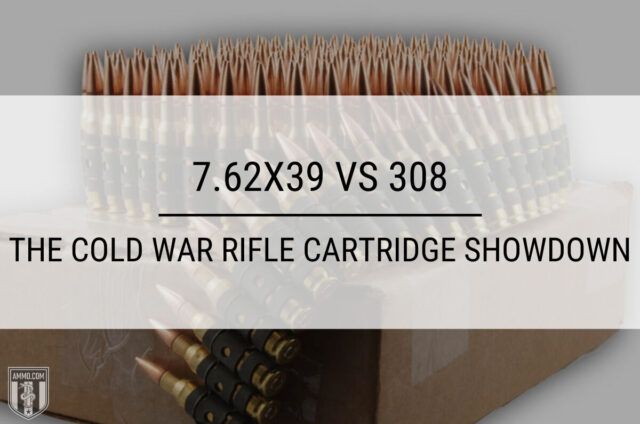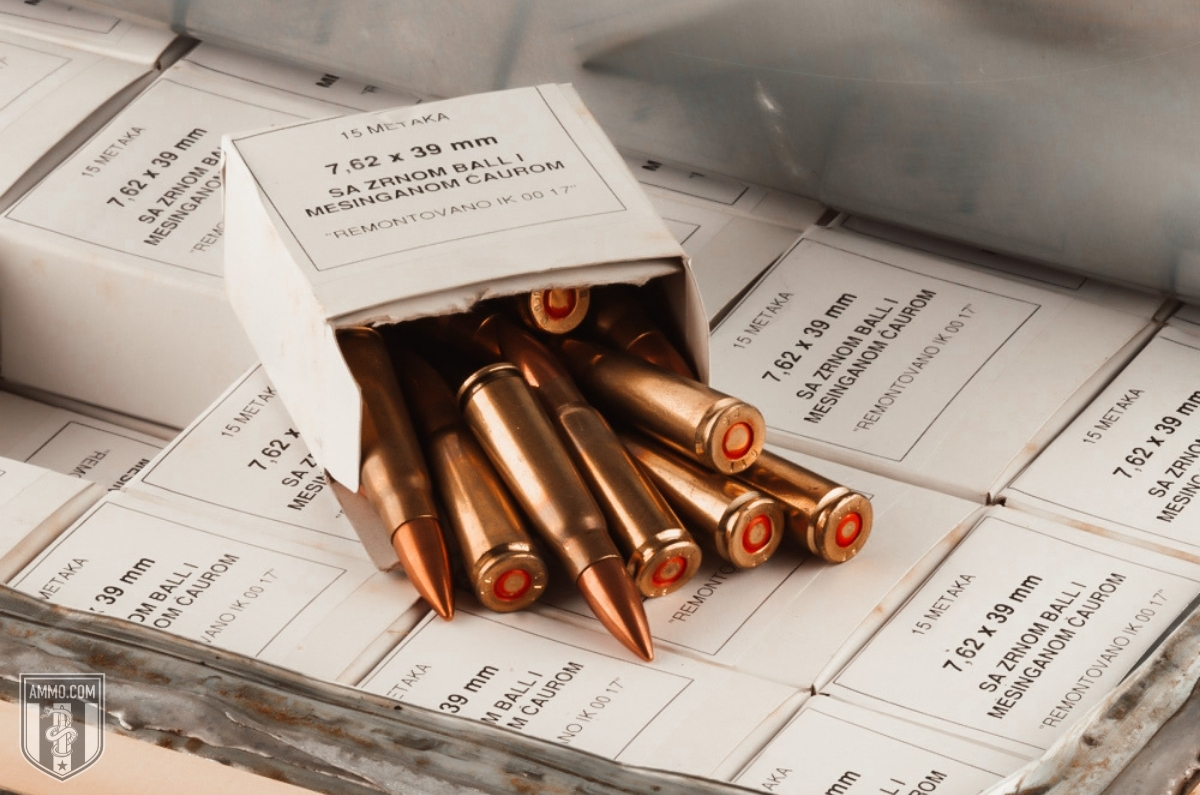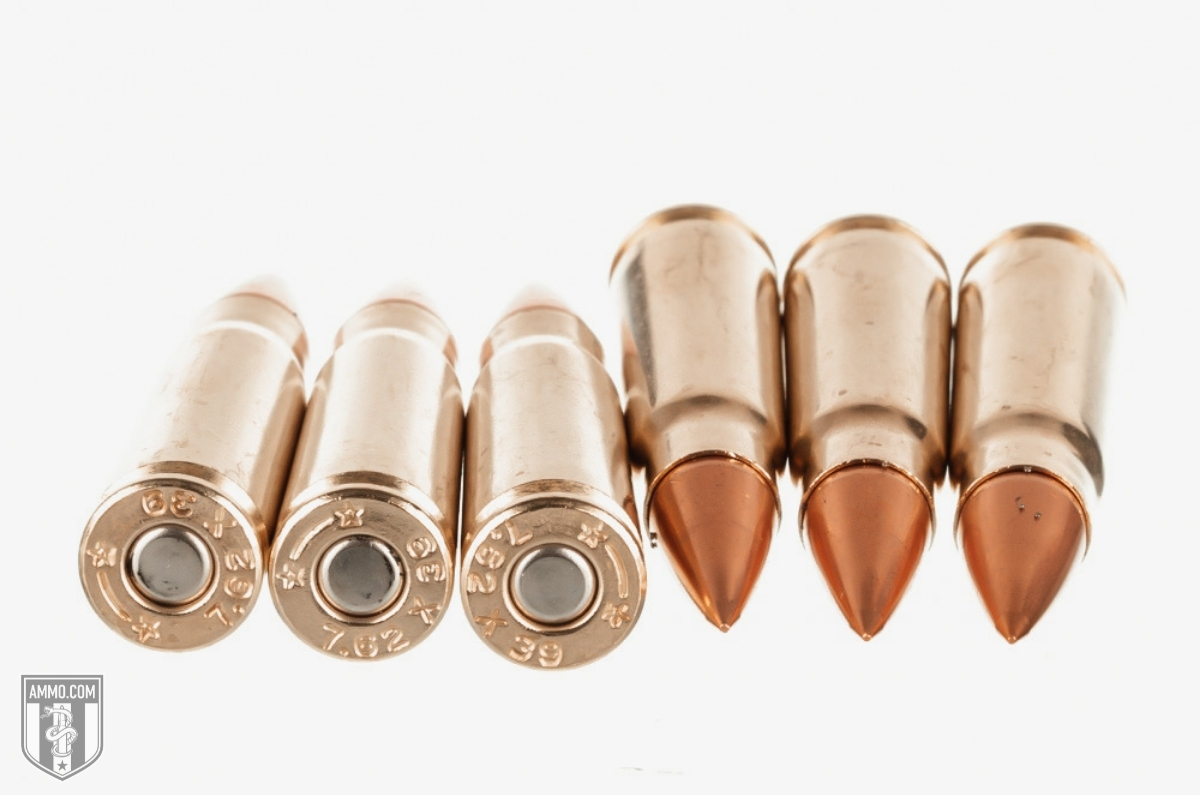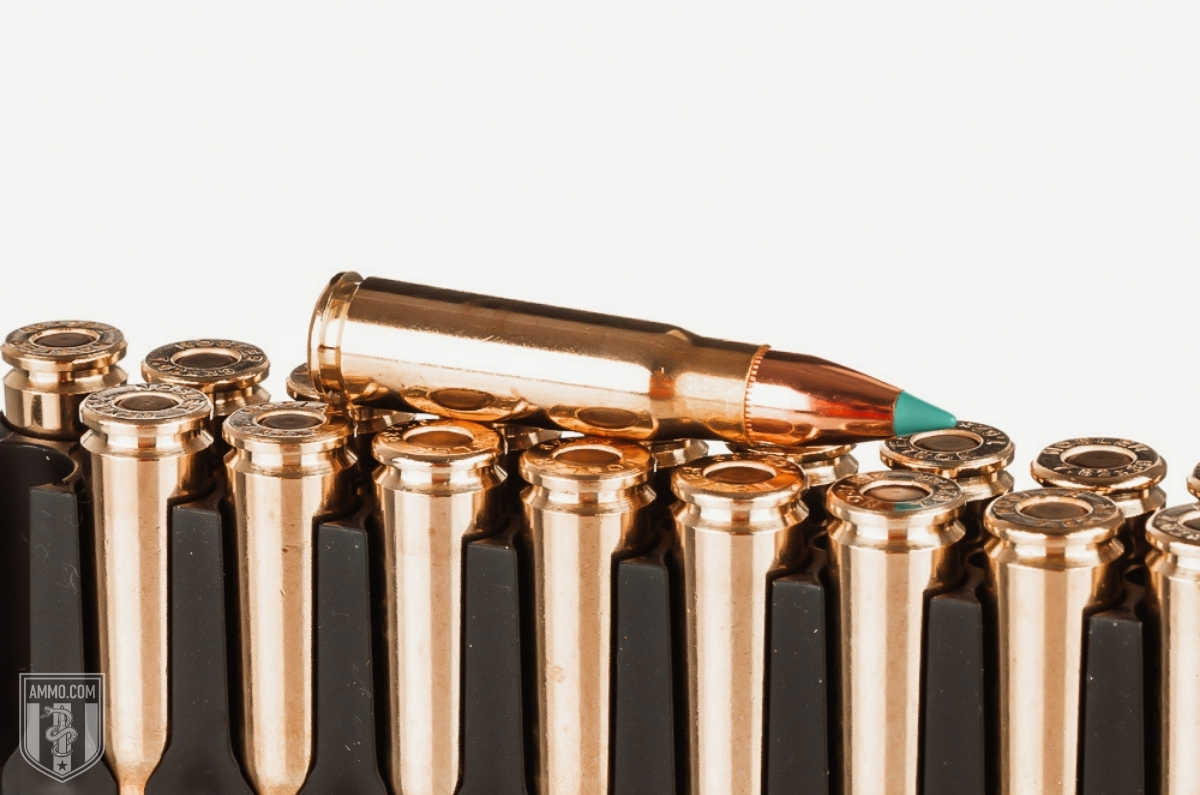When it comes to the scholarly debate about the iconic rifle cartridges of the Cold War, the 7.62x51mm NATO (308 Winchester) and the 7.62×39 Soviet are always omnipresent in the discussion. One became a staple NATO round and the most prevalent big game hunting cartridge in North America, while the other became a symbol of pure, unadulterated ruggedness and dependability.
Both are excellent cartridges and will serve you faithfully, but which is the better choice will depend mostly on your intended purpose.
In this article, we will investigate the origins and history of each rifle cartridge, their advantages and disadvantages, and which rifle cartridge is going to best suit your needs.
It’s time to don your Ushanka and lock and load, comrade, as we are pitting the Pride of Mother Russia against the Freedom Loving long range American powerhouse.
7.62×39: The Hammer of Lenin
During the later stages of WWII, the Soviet Union decided that they wanted to develop an intermediate cartridge for their new battle rifle. They wanted this rifle cartridge to be suitable for a host of firearms, from a semi-auto carbine for close range to fully automatic machine guns for suppressive fire.
Hundreds of unique cartridge designs were submitted but eventually, the Soviets settled on 57-N-231, which had cartridge dimensions of 7.62x41mm.
The first bullet used was not a boat tail design, as the Soviet cartridge designers assumed (incorrectly) that a boat tail design was best only for long range shots. The designer’s assumption that all combat would be held at close range led them to this decision.
However, after extensive testing, the Soviets determined that the boat tail increased close range accuracy as well and a new boat tail bullet was adopted. This longer bullet required the cartridge case to be shortened to 39mm and the ubiquitous 7.62×39 was born.
The 7.62×39 was adopted for the semi-automatic SKS and Mikhail Kalashnikov’s famous battle rifle, the AK-47. The Ak-47 became the most mass-produced military rifle in existence and the 7.62×39 has shared in its success. 7.62×39 ammo fires a 123 grain weight fmj bullet with a muzzle velocity of 2,350 fps for a combat effective range of 400 yards.
With the popularity of the 7.62×39 on the rise, soft point (SP) hunting ammo has become more readily available for hunting whitetail and other medium sized game animals.
The 7.62×39 has seen combat on 5 continents and is truly one of the most prevalent and combat-effective rounds to come out of the Cold War.
.308 Winchester: America’s Long Range Rifle Cartridge
After the Korean War, the US Military saw the writing on the wall and began developing a new cartridge for its frontline soldiers. Although the M1 Garand had conquered the European and Pacific theaters in WWII, the long action 30-06 Springfield round was not the ideal choice for semi-auto and fully automatic fire.
The M1 Garand got the job done in Korea, but the generals knew it was time to put the old girl out to pasture as advancements in rifle technology were surpassing the en bloc fed M1 rather quickly.
With the success of the German designed Sturmgewehr 44 (STG-44) in the latter stages of WWII and the widespread success of the AK-47 afterward, the US Military knew that they needed a select-fire battle rifle for the next evolution of warfare.
In the early 1950s, development began for the new cartridge that would eventually become the 7.62x51mm NATO. However, before being accepted by the US military, the Winchester Corporation jumped the gun and released the cartridge to the civilian market in 1952 as the 308 Winchester.
The 308 Winchester round quickly became a commercial success as Winchester offered it initially in their Model 70 bolt action hunting rifle.
Hunters and long range shooters loved the hard hitting new cartridge and its versatility. Compared to the 30-06 Springfield, the 308 Winchester fit into a short action and had an almost identical ballistic performance with a shorter case length (63mm vs 51mm).
The 7.62x51mm was officially adopted as a NATO round in 1954. The 7.62×51 NATO cartridge and its host rifle, the M14, saw limited use in Vietnam before being replaced by the M16 and the 5.56x45mm NATO (223 Rem).
Although the 7.62 NATO saw only limited use as a battle rifle caliber, it saw extensive use in the US Military’s machine guns and sniper rifles. The 308 Winchester was designed to fire a 147 grain weight bullet with a muzzle velocity of 2,800 fps and muzzle energy of 2,560 ft-lbs for a combat effective range of up to and beyond 800 yards.
The 308 Winchester has truly survived the test of time as it is still popular with hunters, marksmen, law enforcement, and military shooters alike. The 308 offers excellent ballistics (though it is beginning to be over shadowed by the 6.5 Creedmoor) and a long track record of accuracy, power, and sheer combat effectiveness.
308 Winchester vs 7.62×51 NATO: A Note on Nomenclature and Headspace
In the context of this article, we will use the terms 7.62×51 NATO and 308 Winchester interchangeably, however, they are technically different cartridges. Let me quickly explain how.
If you were to look at a 308 Winchester and a 7.62×51 NATO side by side, you’d be hard pressed to tell the difference. However, there are minor differences in the case dimensions that are virtually undetectable to the naked eye.
First off, the 7.62×51 NATO has slightly thicker brass which affects its case capacity slightly.
Furthermore, SAAMI specifications site the maximum pressure for 308 Winchester as 62,000 psi versus 60,191 psi for the 7.62×51 NATO.
Does the case capacity and maximum pressure affect these two rifle cartridges much? Not really.
However, the differences in case dimensions will affect headspace. Headspace is defined as the distance between the breech face and the chamber feature that limits the insertion depth of the cartridge.
7.62×51 NATO chambers are designed with looser tolerances to facilitate smooth insertion and extraction of the NATO round in semi-automatic and fully automatic fire. Conversely, a 308 Winchester chamber has much tighter SAAMI tolerances.
Put these factors together, and what comes out is that the headspace is different between a 308 and a 7.62 NATO.
This begs the question: Can you shoot 7.62×51 NATO and in a firearm chambered for 308 Winchester and vice versa?
The answers are “Yes” and “Most of the time”, respectively.
Picking up a modern rifle, carbine, or handgun chambered in 7.62×51 NATO, most will have chambers built to handle 308 ammo. However, older 7.62 NATO chambers are NOT built to handle the increased pressure of the modern 308 Winchester round.
This means that the higher pressure 308 ammo could rupture a case in the chamber and potentially damage (read: potentially destroy) your older firearm’s chamber, magazine, or YOU.
With all that being said, know what your firearm is chambered in and what pressures it can safely handle. If you are ever in doubt, contact the manufacturer or simply feed it what is stamped on the barrel.
Differences Between 7.62×39 and 308 Winchester: Red Dawn Begins
The 7.62×39 and the 7.62×51 NATO are two very different cartridges. Each cartridge has its own advantages and disadvantages depending on your intended purpose.
The goal of this article is to inform you of these differences so that you can select the best rifle caliber for your needs. We will not be “crowning a winner” as they each excel in their own role.
With that out of the way, let’s compare both of these outstanding military cartridges head-to-head!
7.62×39 vs 308: Cartridge Specs
When comparing two different cartridges, it’s a good practice to look at the cartridge case itself to glean some information.
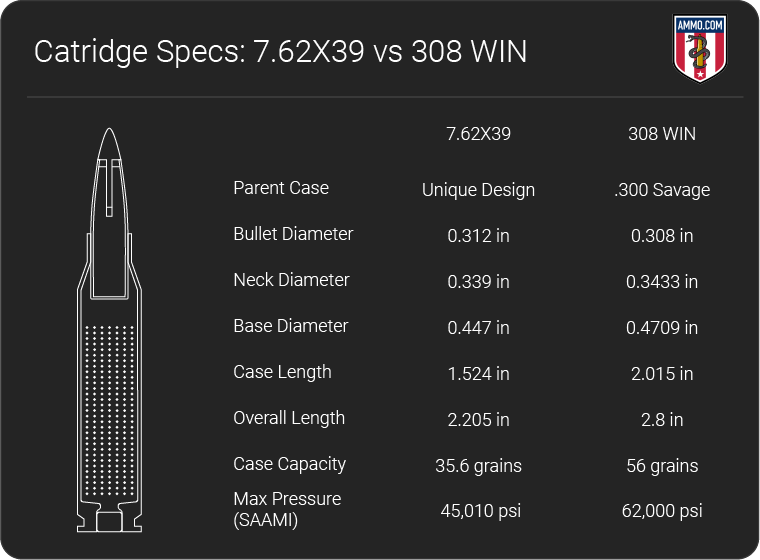 Right off the bat, we have to tackle the biggest issue that I hear from new handloaders. The 7.62×39 does not fire a .308” diameter bullet, it actually fires a 0.312”.
Right off the bat, we have to tackle the biggest issue that I hear from new handloaders. The 7.62×39 does not fire a .308” diameter bullet, it actually fires a 0.312”.
This causes a lot of confusion because of the nomenclature: 7.62×39 vs 7.62×51 NATO.
Based on the name alone, you would reasonably expect that they would fire the same bullet diameter…but they don’t!
This can be tricky to wrap your head around the first time so I wanted to bring it up first.
The next major difference between these two rifle cartridges is the difference in case capacity. The 308 Winchester has almost 40% more case capacity compared to the Russian 7.62×39 (56 gr vs 35.6gr).
This makes a lot of sense as the 308 Winchester cartridge case is a good half-inch longer than its Russian counterpart – a longer cartridge will mean more case capacity.
That extra powder charge will affect recoil, range, and trajectory, which we will cover below.
Lastly is the max pressure difference, as the 308 Winchester can handle 17,000 psi more than the 7.62×39.
7.62×39 vs 308: Recoil
Recoil is something that a lot of shooters worry about, not so much because of physical pain (though this can be an issue), but more so for follow-up shots. Compared to a cartridge with less recoil, more felt recoil will buck the muzzle off the target more, slowing follow-up shots.
Felt recoil will be directly related to the rifle weight, bullet weight, powder charge, pressure, and shooting stance.
When it comes to this comparison, there is simply no contest. I’m pretty sure that you can guess already which rifle cartridge is going to have more recoil.
That’s right, the 308 Winchester has almost 2.5 TIMES MORE felt recoil than the 7.62×39.
On average, the 7.62×51 NATO will have a felt recoil of approximately 22 ft/lbs while the 7.62×39 recoil will clock in around 8.7 ft/lbs. That is a “night and day” type difference!
Follow-up shots will be faster with the 7.62×39 and shoulder wear will be considerably less.
The 308 Winchester dwarfs the 7.62×39 in cartridge dimensions, which means that the 308 Win is going to be firing heavier bullets at higher pressure, muzzle velocity, and muzzle energy. All of this adds up to more felt recoil.
Now, is the 308 Winchester’s recoil overly oppressive? I’d say not in the least.
Any adult marksman will not have a problem handling a 308 Win recoil impulse; however, some smaller frame or younger shooters might.
If you’re a new shooter, training a child, or simply sensitive to recoil, you might want to look at a 7.62×39 before you get a 308 Winchester. Otherwise, the 7.62×51 NATO recoil is very manageable.
7.62×39 vs 308: Accuracy
Accuracy is a tricky category to talk about because so much depends on the platform used and the shooter. However, I’m going to go out on a limb here and say that the 308 Winchester is going to be the more accurate cartridge in general.
Now before all my 7.62×39 shooters get triggered, let me explain.
As you’ll see in the following ballistics sections, the 308 simply has better ballistics. It has a flatter trajectory, higher muzzle velocity, higher supersonic limits, and a better ballistic coefficient.
The second consideration to accuracy is the cartridge case material. As mentioned earlier, almost all 7.62×39 ammo is steel case. You can find steel case 308 Winchester ammo but the majority is brass case.
To make a long story short, brass is more malleable than steel and will create a better seal around the chamber when a cartridge is fired. This seal means that less gasses will escape back into the chamber and the powder will burn more consistently.
Steel case ammo does not deform much during firing and so the seal around the chamber is much less so more gasses will come back into the chamber.
Again, accuracy is directly related to consistency and it’s my opinion that average factory 308 ammo is going to be inherently more accurate than anything short of match grade 7.62×39 ammo.
7.62×39 vs 308: Trajectory
The trajectory is the measure of a bullet’s path in flight. We measure this in terms of how far a bullet drops at a given distance.
We are somewhat limited on bullet weight options for the 7.62×39 as the 123 gr bullet is our only option.
For 308 Win, there are plenty of different grain weight bullets to choose from, however for the purpose of this discussion we will limit it to the 150 gr option.
Assuming both rifles have a 200 yard zero, performance out to 300 yards is fairly similar. The 308 has dropped a little less at -8.5” compared to -14” for the 7.62×39. However, this is where the proverbial bottom falls out.
Once we get out to the 400-yard mark, the 308 pulls away and that extra muzzle velocity from the larger powder charge really pays off. At 400 yards, the 308 will have dropped approximately -26” while the 7.62×39 is crashing down -44”.
The 7.62×39 is hemorrhaging velocity at this point and is nearly subsonic at 400 yards while the 308 is just steamrolling through the yardage markers.
A bullet’s supersonic limit is the range at which its velocity traverses below the speed of sound (1125 fps). Once a bullet goes subsonic, accuracy suffers greatly.
In general, the 7.62×39 will go subsonic around 500 yards while the 308 Winchester will not even think about going subsonic until it hits 1000 yards.
With its higher powder charge, the 308 Winchester has a considerably longer range and a flatter trajectory than the 7.62×39.
7.62×39 vs 308: Ballistic Coefficient
Ballistic coefficient is a number that many shooters will run across when doing cartridge research but often have no idea what it means.
To put it in layman’s terms, the ballistic coefficient is the numerical representation of how aerodynamic and streamlined a bullet is. The higher the number, the less the bullet will be affected by wind drift and air resistance.
When it comes to the ballistic coefficient between the 308 Winchester and the 7.62×39, the 308 simply dominates. On average, the 308 has a ballistic coefficient of 0.434 while the 7.62×39 averages in around 0.27.
This means that the 308 Winchester bullets are more streamlines and now the massive velocity loss that we observed with the 7.62×39 at longer distances makes a lot more sense.
7.62×39 vs 308: Sectional Density
Sectional Density is the measure of how well a bullet penetrates a target. This is extremely important for game hunters who need a bullet that can punch through thick hide, bone, and sinew.
Sectional density is calculated by comparing the bullet weight and the bullet diameter, the higher the number the more effective it will be at penetrating a target.
The 7.62×51 NATO dominates in the penetration department as well with an average sectional density of 0.25 vs 0.18 for the 7.62×39.
This would indicate that the 308 Winchester will have deeper penetration than the 7.62×39, which can be a good or a bad thing depending on your intended purpose (more on that later).
7.62×39 vs 308: Ammo Price and Availability
When it comes to price and buying in bulk, you simply cannot beat the cost-effectiveness of the 7.62×39. Although that Russian ammo might be a bit on the inconsistent side, it is affordable and easy to get your hands on large quantities.
As of the writing of this article, you can easily pick up non-corrosive 7.62×39 at $0.32/round. If want to go even cheaper, you could pick up a surplus spam can for even less. Just be aware that anything coming from a spam can is going to be corrosive and you’ll need to add extra cleaning steps after firing.
308 Winchester is going to be considerably more expensive as everything about the rifle cartridge is bigger. It has a bigger bullet, cartridge case, and powder charge.
he cheapest 308 ammo is steel cased at $0.60/round…almost double the cost per round compared to 7.62×39. And it only goes up from there.
Quality 308 hunting ammo will run you no less than $1/round if not higher.
When it comes to volume shooting you simply cannot beat the 7.62×39, but your bullet options are going to be a lot less.
The majority 7.62×39 comes with a bullet weight of 123 gr in either soft point (SP) or full metal jacket (fmj).
On the other hand, 308 has a wide variety of bullet options. Fmj, hollow point match grade, spitzer, ballistic tip, soft point, partition, and a myriad of other specialty bullets are all available in 308.
Furthermore, you have a wide range of bullet weights at your disposal. Options are available all the way from lightweight 120 gr bullets to a heavier bullet tipping the scale at 180 gr.
If you want to shoot in bulk on the cheap, 7.62×39 is the rifle caliber for you. However, if you’re looking for some specialty bullets to accomplish a specific task, 308 Winchester will better suit your needs.
And remember, buying in bulk is always smart, make sure to check out our stock of bulk 308 ammo and 7.62×39 bulk ammo.
7.62×39 vs 308: Rifle Availability
When it comes to rifle availability, there are multiple options for each cartridge; however, each excels in a different firearm type.
For bolt action rifles, there are options in 308 from every major gun manufacturer. You can easily pick up a Remington 700, a Savage Axis, or a Ruger American chambered in 308 in almost any gun store across the continental United States.
However, if you’re wanting a bolt action rifle in 7.62×39 your options are much more limited. The Ruger American Ranch and the CZ 527 are really your only major options.
When it comes to semi-automatic options 7.62×39 takes the top spot. As I mentioned earlier, the AK-47 is the most mass-produced rifle on the planet, and you have a plethora of options if you want to go this route. Or if you prefer the SKS platform, those are easy to come by as well and won’t break the bank.
Several companies have modified the AR platform to run 7.62×39, the most notable of these being the CMMG Mutant.
For the 308 Winchester, semi-automatic options are a bit pricier but still plentiful. The AR-10 platform is by far the most popular in the USA but you are not limited to just that. The Springfield M1a, FN-FAL, Scar 17, and Kel-Tec RFB are all viable 308 Win semi-auto options.
To sum it all up, for bolt action rifles the 308 is king. For inexpensive semi-automatic options, the 7.62×39 cannot be beat.
7.62×39 vs 308: Hunting
7.62×39 has become more popular for hunting as of late, however I contend that the 308 Winchester is the better option for medium to large game hunting.
One major issue with using 7.62×39 for hunting is the bleeding of velocity that we discussed earlier in the Trajectory section. As a bullet slows down, it also loses kinetic energy.
The consensus among hunters is that the lowest acceptable muzzle energy a bullet should have to ethically claim a whitetail or other medium-sized game animal is 1000 ft-lbs. The 7.62×39 is well below this threshold at 200 yards. That’s a pretty short effective range for hunting deer.
On the other hand, the 308 Winchester is still steamrolling well over 1000 ft-lbs at 500 yards.
There’s no denying that the 7.62×51 NATO is the superior long range choice for medium to large sized game.
The 7.62×39 should NOT be used for anything larger than a whitetail as it lacks the kinetic energy to ethically harvest the animal. Trust me, no Alaskan guide is carrying an AK-47 into bear country, the round simply does not have enough knockdown power to be effective.
Then there’s the issue of rifle selection as some states do not allow semi-auto rifles for deer hunting due to fair chase regulations. This means that your options for 7.62×39 are extremely limited when it comes to a bolt action hunting rifle.
Now I’m sure that it sounds like I’m saying that the 7.62×39 is not effective for hunting, and that’s not actually the case. For deer hunting it’s an acceptable choice, there are just better options like the 6.5 Creedmoor, 243 Winchester, 30-06 Springfield, 300 Win Mag, and of course 308 Winchester.
But where the 7.62×39 excels at hunting is in varmint control for feral hogs, coyotes, and groundhogs.
The low recoil impulse of the 7.62×39 makes it an ideal cartridge for this application as it allows for quicker follow-up shots. This can be useful for engaging multiple targets like feral hogs that often travel in herds and can decimate an entire field in a night.
Hunting regulations for varmints are typically a lot less stringent (read: semi-automatics are acceptable) and bag limits are higher, if not unlimited.
To sum it all up, if you are planning on hunting at long range then you should grab your Remington 700 or Savage 110 chambered in 308 Winchester. If you’re going out to do some varmint control, then lock and load your SKS or AK-47.
7.62×39 vs 308: Reloading
If you like to reload as I do, then there are two major reasons why you decided to get into handloading:
1) Cost per round reduction
2) Customizing your own ammo for maximum performance
If you want to optimize your hunting rifle for longer range shooting and maximum lethality for big game, then reloading is definitely the way to go.
However, of these two rifle cartridges, only the 308 Winchester is cost-effective to reload. For the 308 Winchester, brass, powder, and bullets are all plentiful and you can customize your handloads to your heart’s content.
Furthermore, the overwhelming majority of brass case 308 is Boxer primed, which is needed for reloading.
If you want to shoot heavier bullets for big game like elk and caribou, you have tons of options from Hornady, Berger, Barnes, and Nosler.
This is not the case for the 7.62×39.
The first issue is that almost all cartridge cases for 7.62×39 are steel and Berdan primed. You should not reload steel cases as they will damage your reloading dies and decapping Berdan primers is a major pain in the neck.
This means that you will need to purchase new, Boxer primed 7.62×39 brass which is going to add to your cost. Furthermore, bullet options are somewhat limited (and more expensive) for 0.312” diameter bullets when compared to the .308” bullets.
When you add these things together, it is cheaper to buy factory new 7.62×39 ammo than handloading it. You can eke out a little more performance from the 7.62×39 from reloading, but you will not turn your AK-47s into long range sniper rifles like you can with a 308 bolt action rifle, that much I can promise you that.
If you like reloading, then 308 is the only choice as 7.62×39 is simply not cost-effective to reload due to lack of components and the benefits are not worth the added cost.
7.62×39 vs 308: Self-Defense
Earlier we discussed penetration – the 308 Winchester will typically penetrate deeper than 7.62×39. This can be a benefit in the field when you’re hunting bear or elk, but it can be a major problem in a self-defense situation.
Overpenetration is a huge liability when it comes to self-defense because you want all of your rounds fired to stay within the intended target (bad guy).
A firearm instructor once told me, “Assume every bullet you fire has a lawyer attached to it.” This means that you are liable if you injure an innocent bystander, even in a self-defense situation.
Therefore, we want to minimize overpenetration as much as possible as modern home construction utilizes rather flimsy material that is ineffective at stopping heavy rifle calibers.
With all that being said, the 308 Winchester is going to over penetrate more than I’m comfortable with during a close range self-defense situation. The last thing I want is for my 308 Winchester round to end up in my neighbor’s house because I’m liable for any damage it causes to the property or its occupants.
The 308 simply has too much muzzle energy to be utilized in an indoor urban or suburban setting and you would be much better suited utilizing a 7.62×39 or even 300 Blackout ammo in this situation.
For close range self-defense, the 7.62×39 is the better option as it has lower recoil for quicker follow-up shots and penetrates the target less than a 308 would. This reduces, but does not eliminate, the potential to injure an innocent bystander.
7.62×39 vs 308: Ballistics Tables
I know a lot of my readers love to look at the ballistics tables that our experts here at Ammo.com have put together for you.
7.62×39 ballistics are often compared to the 30-30 and 300 Blackout ammo, and these ballistics tables support that claim.
You can see why the 308 ballistics make it the ideal long range option with increased muzzle velocity, muzzle energy, and a flatter trajectory.
308 Ballistics
Note: This information comes from the manufacturer and is for informational purposes only. The actual ballistics obtained with your firearm can vary considerably from the advertised ballistics. Also, ballistics can vary from lot to lot with the same brand and type load.
7.62×39 Ballistics
Note: This information comes from the manufacturer and is for informational purposes only. The actual ballistics obtained with your firearm can vary considerably from the advertised ballistics. Also, ballistics can vary from lot to lot with the same brand and type load.
7.62×39 vs 308: Conclusion
When it comes to selecting your new rifle caliber, there are many factors to consider. Your intended purpose needs to play a major role and understanding the advantages and disadvantages of any given rifle cartridge is tantamount to making the correct selection.
When it comes to 7.62×39 rifle rounds, you are getting a lot of close range power in a tight package.
Semi-automatic rifles like the SKS and AK-47 are readily available at reasonable prices and magazines are easy to acquire. 7.62×39 ballistics mirror 30-30 and 300 Blackout ammo and are very effective at close range (under 200 yards).
The 7.62×39 can be utilized for medium game hunting, like whitetail deer, with proper soft point ammo and shots taken under 200 yards; however, the 7.62×39 really excels when it comes to varmint hunting and self-defense as its low recoil allows for faster follow-up shots for engaging multiple targets.
If you’re looking to really shoot long distance and hunt medium to big game, then the 308 Winchester is the clear choice. Its long range ballistics are vastly superior to the 7.62×39 as the 308 has higher muzzle velocity, muzzle energy, a flatter trajectory, and an effective range well past 500 yards.
308 Winchester also allows for handloading custom ammo as components are easily accessible, whereas the 7.62×39 is simply not cost-effective or convenient to reload.
Which one would I pick? Both!
Both the 308 Winchester and 7.62×39 are battle-proven rifle rounds and will serve you well so long as you do your part with shot placement. They both excel in their intended purpose and both will find a wonderful home in your gun safe.
No matter which rifle cartridge you choose, make sure you get out to the range and flex your Second Amendment rights as much as possible, lest they be lost to incremental restrictions that infringe on our liberties.
7.62×39 vs 308: The Cold War Rifle Cartridge Showdown originally appeared in The Resistance Library at Ammo.com.

